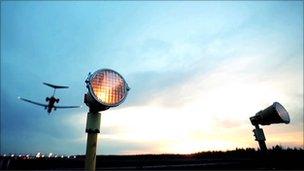GPS overlay 'ready for plane use'
- Published

Egnos is part of a wider initiative to improve the efficiency of air transportation across Europe
The European system that augments GPS signals to make them more accurate is now suitable for use in aviation, the European Commission says.
, the European Geostationary Navigation Overlay Service, can tell planes and helicopters where they are to within a couple of metres.
The system was certified for "safety of life" applications on Wednesday.
This means its performance is of a high enough standard that pilots can reliably use it as a navigation tool.
Big airliners landing at major international airports typically rely on ground technologies to guide them to a runway, but Egnos is likely to help with some final approach phases and in improving the positioning of aircraft en route.
The system should be more important at some small airports where the ground infrastructure is much more limited.
Antonio Tajani, Vice-President of the European Commission, made the Egnos announcement in London.
He told 91热爆 News that Egnos and the soon to launch Galileo system - a European version of GPS - were key initiatives for the EU and its interests in space.
"I believe in Egnos and Galileo, not because they are my dream, but because they are part of our industrial policy," he said.
"Space may be up there," he added, pointing to the sky, "but Egnos and Galileo will deliver services to the citizen here on the ground."
Egnos is a joint project of the European Commission, the European Space Agency (Esa), and Eurocontrol, the European organisation for the safety of air navigation.
It started initial operations in 2005 and has gradually ramped up its service.
Integrity assured
The system comprises three geostationary satellites and a network of ground stations.
It receives GPS signals, analyses and corrects errors, and then transmits that updated information to users.
Egnos also transmits integrity messages, or warnings, if there is a major problem in the sat-nav process.
Users with the right equipment can get fixes vertically and horizontally that are, in most instances, accurate to decimetres - certainly better than two metres.
The uncorrected GPS signal, on the other hand, may be many metres out.
The assurance, together with those tested accuracies, makes Egnos now suitable for applications where lives may depend on its performance.
Aviation is one such application, but any guided means of transport stands to benefit.
Search and rescue helicopters are likely to use Egnos for very precise positioning in bad weather.
Professor Terry Moore, an expert on satellite navigation from the University of Nottingham, commented: "An important aspect of this is also about using the airspace more efficiently.
"For example, this means more effective traffic control such that aircraft arrive at big airports like Heathrow and Gatwick at a time when they can go straight into a landing rather than having to enter a stack.
"Having more reliable information about timing and where all the aircraft are will deliver huge savings in fuel and greenhouse gas emissions.
"Better management of timing means we are not wasting fuel in aircraft waiting on the ground to take off and in aircraft in the air waiting to land."
At the moment, Egnos provides its service over the European economic area, but Mr Tajani said he was very keen to see coverage extended to Africa and even South America.
The EC VP, who is in charge of industrial policy in Brussels, called Egnos the "father" of Galileo.
That system, which is intended to deliver high-precision timing and navigation signals to the entire globe, will begin its roll-out this year.
Four satellites will go into orbit initially in the coming 12 months to verify the network's operability. A further 14 spacecraft will then follow by the end of 2014.
This 18-satellite phase of Galileo is costing EU member states in excess of three billion euros. Completion of the network, requiring 12 additional spacecraft, was recently projected to cost an extra 1.9 billion euros.
Mr Tajani said he hoped to agree with member states how to fund the completion of Galileo later this year. "I want to reduce this cost," he told 91热爆 News.
"It is possible with many supporters - the commission, the member states, Esa, and the companies involved. It won't be easy, but this is my strategy."
- Published18 January 2011
- Published17 January 2011
- Published26 October 2010